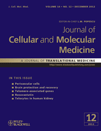Spinal cord injury causes bone loss through peroxisome proliferator-activated receptor-γ and Wnt signalling
Abstract
It has long been recognized that spinal cord injury (SCI) leads to a loss of bone mineral. However, the mechanisms of bone loss after SCI remain poorly understood. The aim of this study was to investigate whether SCI causes a shift in skeletal balance between osteoblastogenesis and adipogenesis. Eighty male Sprague-Dawley rats at 6 weeks of age were randomly divided into two groups: sham-operated (SHAM) group and SCI group. The rats were killed after 3 weeks, 3 months and 6 months, and their femora, tibiae and humeri were collected for mesenchymal stem cells (MSCs) culture, bone mineral density (BMD) measurement, RNA analysis and Western Blot analysis. Osteogenic and adipogenic differentiation potential of MSCs from SCI rats and SHAM rats was evaluated. We found increased marrow adiposity in sublesional tibiae of SCI rats. SCI caused increased peroxisome proliferator-activated receptor-γ (PPARγ) expression and diminished Wnt signalling in sublesional tibiae. Interestingly, in MSCs from SCI rats treated with the PPARγ inhibitor GW9662, the ratios of RANKL to OPG expression were significantly decreased. On the contrary, in MSCs from SCI rats treated with the PPARγ ligand troglitazone, the ratios of RANKL to OPG expression in SCI rats were significantly increased. High expression of PPARγ may lead to increased bone resorption through the RANKL/OPG axis after SCI. In addition, high expression also results in the suppression of osteogenesis and enhancement of adipogenesis in SCI rats. SCI causes a shift in skeletal balance between osteoblastogenesis and adipogenesis, thus leading to bone loss after SCI.




